Alvati is a very popular recipe from GSB Konkani cuisine that is spicy, tangy, and creamy with unique flavors prepared using colocasia leaves (taro leaves, tere paan).
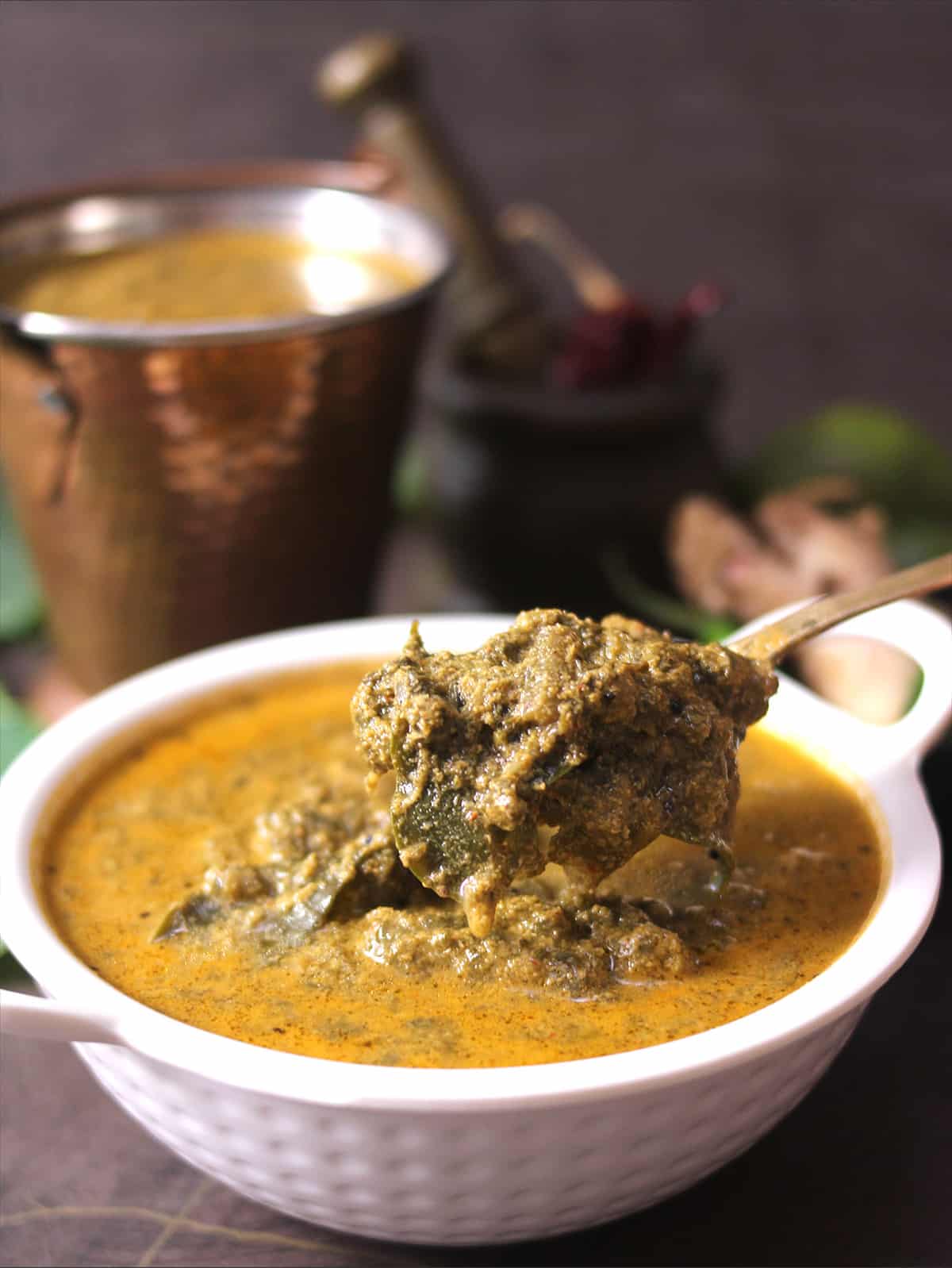
About the recipe
Alvati is traditionally made using young tender colocasia leaves, which are first pressure cooked till it becomes soft, and then continued to cook in coconut paste along with ginger, green chilies, curry leaves, and hog plum (ambado).
Alvati is a special recipe popularly prepared at SVT, Karkala, my hometown, during Ananth Chaturdashi (Nopi). The crowd gathers here for lunch just to enjoy this alvati. When prepared on a large scale, the taste of the curry is totally different.
In some places, it is prepared for Sri Krishna Janmashtami. But if you are from a typical Konkani household, then you will not wait for any of these special days to prepare alvati. During the rainy season, when the leaves are available in plenty, you either make patrado or tere panna alvati.
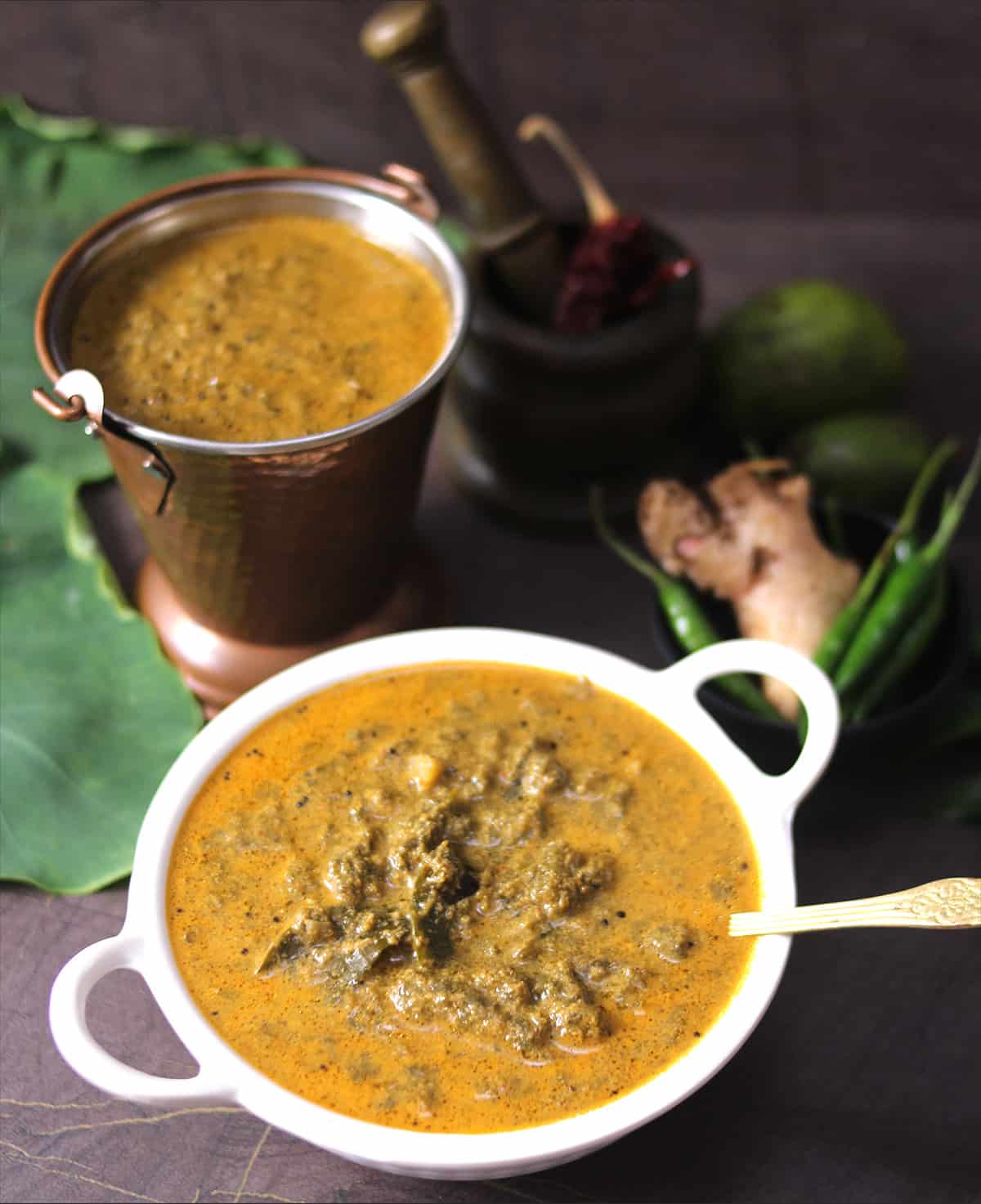
There are variations to this recipe in every household. The recipe shared below is what my husband loves the most. You can also add jackfruit seeds (bikkand), fresh bamboo shoots (kirlu), chickpeas, and peanuts.
Some names for alvati are colocasia leaves curry, patra leaves curry with bamboo shoot, arbi leaves, kirla randai, taro leaves curry, etc. All means the same. In Kannada, colocasia leaves are called kesuvina yele (ಕೆಸುವಿನ ಎಲೆ).
But if you go to Maharastra, the curry prepared using colocasia leaves is called Alu Chi Bhaji; in Goa, it is called Terre Tonak; in Kerala, it is called chembila curry. The spices added in each region are different.
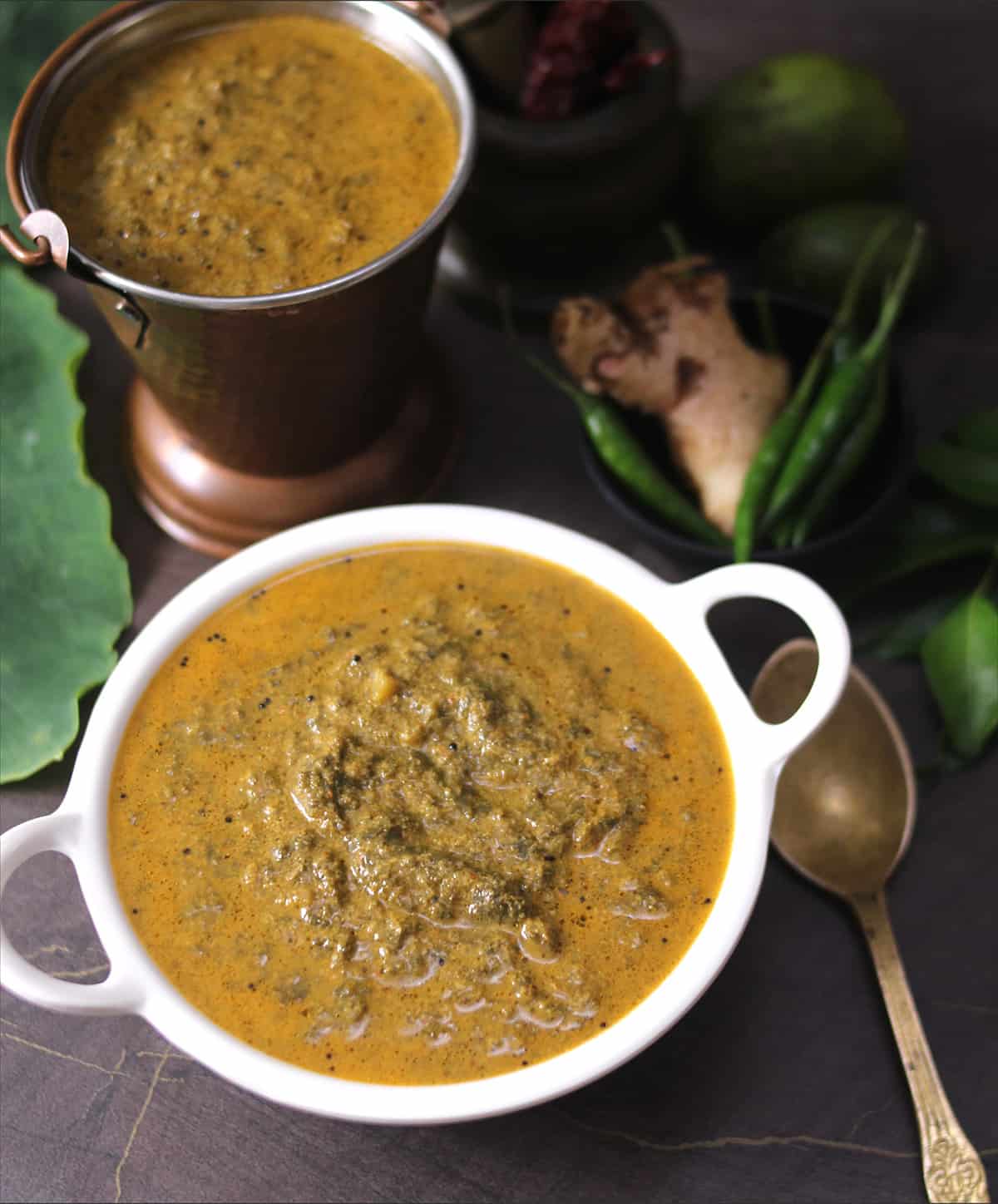
Which Colocasia leaves should I use
The type of leaves you use and the time of the year you prepare the dish influences the final taste and texture of the curry. Young and tender leaves (tere paan) that are generally available in plenty during the rainy season is best suited for making alvati. The tender leaves cook faster and make your dish creamy and buttery.
If you use the matured leaves (larger and older leaves) that are primarily available in early to mid-summer, it takes a longer time to cook, and the curry will not be as soft and creamy as you desire. Also, mature leaves are slightly itchy when not cooked for a long time. The itchiness is due to a compound called calcium oxalate in matured leaves.
Ingredients used and their importance.
Colocasia leaves - This is the main ingredient in the recipe. But if you want to try this dish off-season (after the monsoon), use palak or spinach.
Hog plums or Ambado - The reason behind using tangy ingredients is that colocasia leaves, when not cooked properly, will cause an itching effect (korju) in your mouth and throat because of the calcium oxalate present in them. The sourness or acid in the hog plums helps break down this compound, thereby eliminating itching to a large extent.
If ambado (hog plums) are not available, then use bilimbi (bimbul) or star fruit (karmbal).

Ginger - Its flavor with spicy aroma gives an additional kick to the dish. Don't skip adding ginger, or don't add a small amount. These days ginger available in the market is large in size but has no flavor unless it is fresh from your own farm. Add a little extra. Otherwise, you will miss the warm flavor ginger adds to the dish.
Green chilies - This is added to give extra heat to the dish.
Curry leaves (optional) - For its health benefits and flavor, it is added in curry preparation.
Coconut masala paste - No Konkani curry is complete without adding coconut masala. While making this masala, coconut and dry red chilies are traditionally used. But I love my mom's recipe, where she adds a few cashews while making the paste. The addition of cashews makes your dish rich and creamy.
Finally, the tempering - The tempering is very basic. In hot oil, let the mustard seeds splutter and then add curry leaves and saute until they turn crispy.
To make it authentic temple style add kirlu (bamboo shoots), bikkand, venti if available.
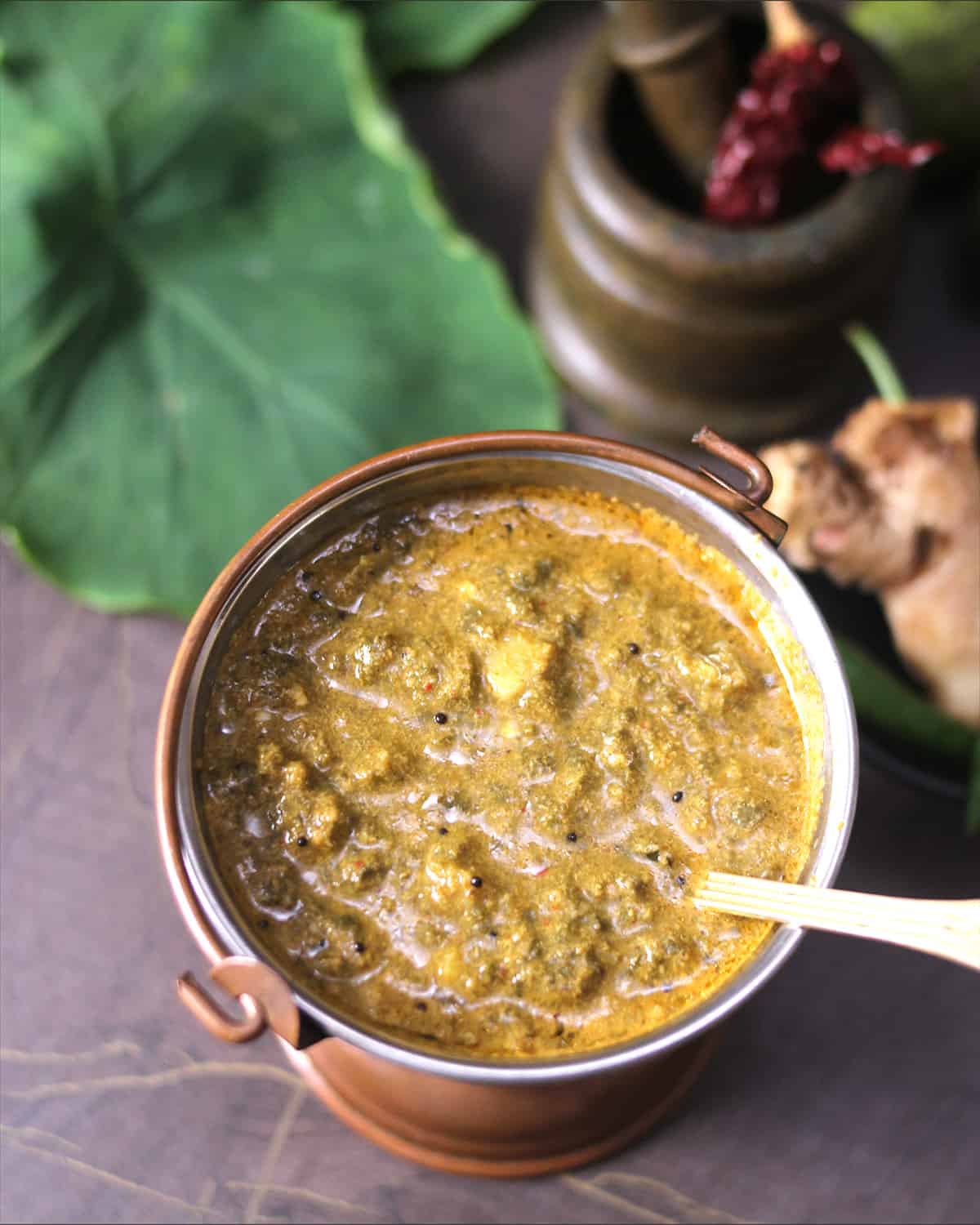
Ingredient amounts
6 to 8 cups Young Colocasia leaves (Taro leaves), roughly chopped
3 Hog plums (ambado), crushed you can even use bimbul or star fruit
2 inch Ginger, chopped or crushed
3 Green chilies, slit
8 to 10 Curry leaves
Salt, to taste
For the coconut masala
2 cups Coconut (loosely packed)
3 to 4 Dry red chilies (For green color, reduce red chilies to 2)
1 to 2 tablespoon Chopped cashews
For the tempering
2 tablespoon Coconut oil
1 teaspoon Mustard seeds
6 to 8 Curry leaves
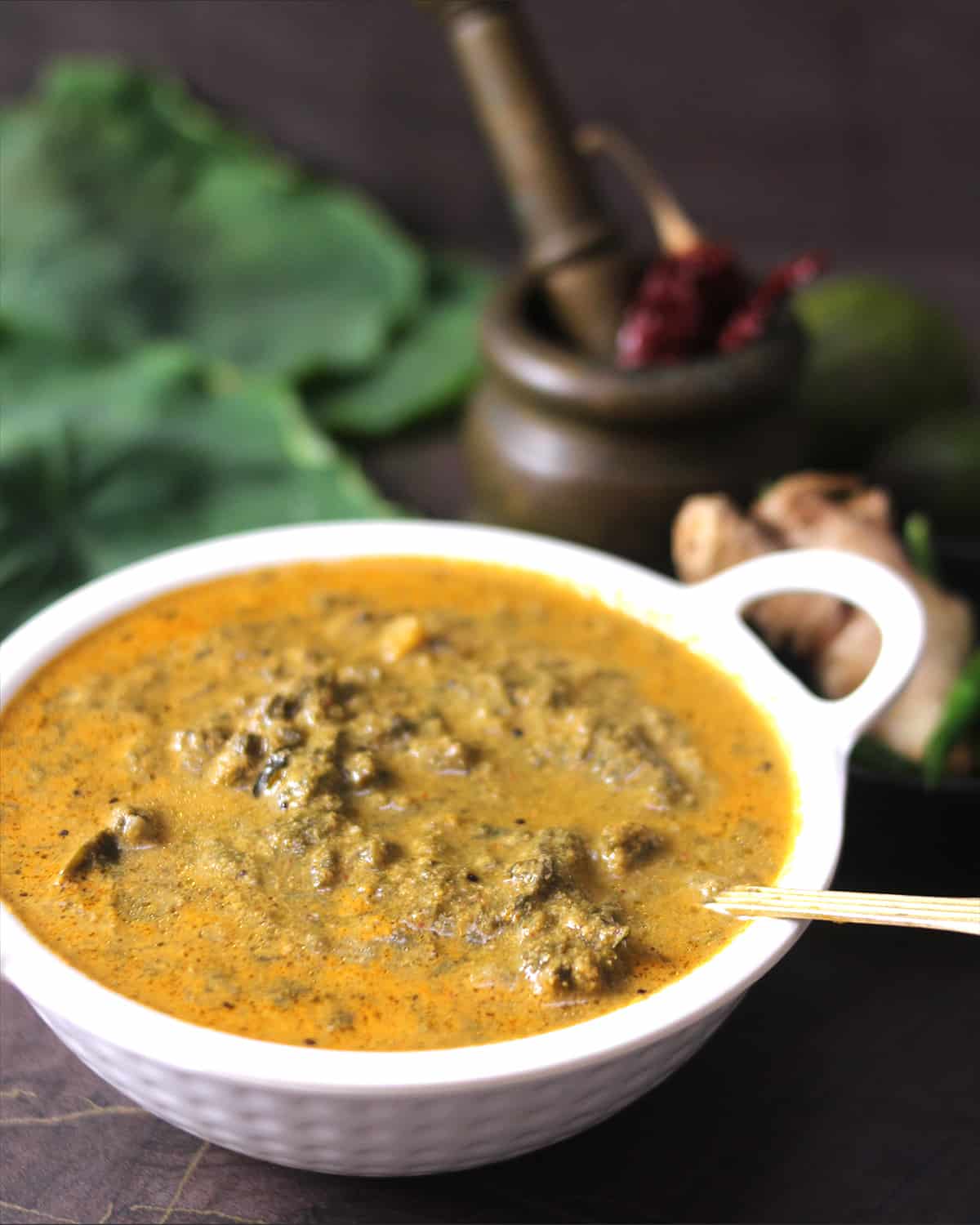
How to make the best tere panna alvati at home ?
Pressure cooking the colocasia leaves
Nicely wash the roughly chopped leaves and add them to the pressure cooker along with water and pressure cook for 3 to 4 whistles. Even if you add more leaves, it is OK. The leaves are going to wilt when there are cooked.
Let the cooker cool down and release the pressure naturally.
Open the lid, and now if you see that the water is more, transfer the excess water to another vessel and use it later in the curry only if needed.
Now using the whisk, nicely whisk the cooked leaves for a minute or two. Whisking will further break down the cooked leaves and make your dish smooth.
Make the coconut curry paste
In a mixie jar or blender, add coconut, red chilies, and cashews with little water and blend it to smooth paste.
Making of alvati
To the whisked colocasia leaves, add ginger, green chilies, curry leaves, coconut paste, and salt, and bring it to a nice boil. If you feel the gravy is too thick, only then add water or reserved water from before. Else skip.
Bring it to a boil and simmer on medium flame for 5 to 10 minutes so that the flavors are well combined.
Make the tempering.
In a small pan, heat the oil. Once the oil is hot, add mustard seeds. When they start to splutter, add curry leaves and saute for a few seconds.
Finally, add the tempering to the curry and switch off the flame.
Happy Ananth Chaturdashi to all of you!!
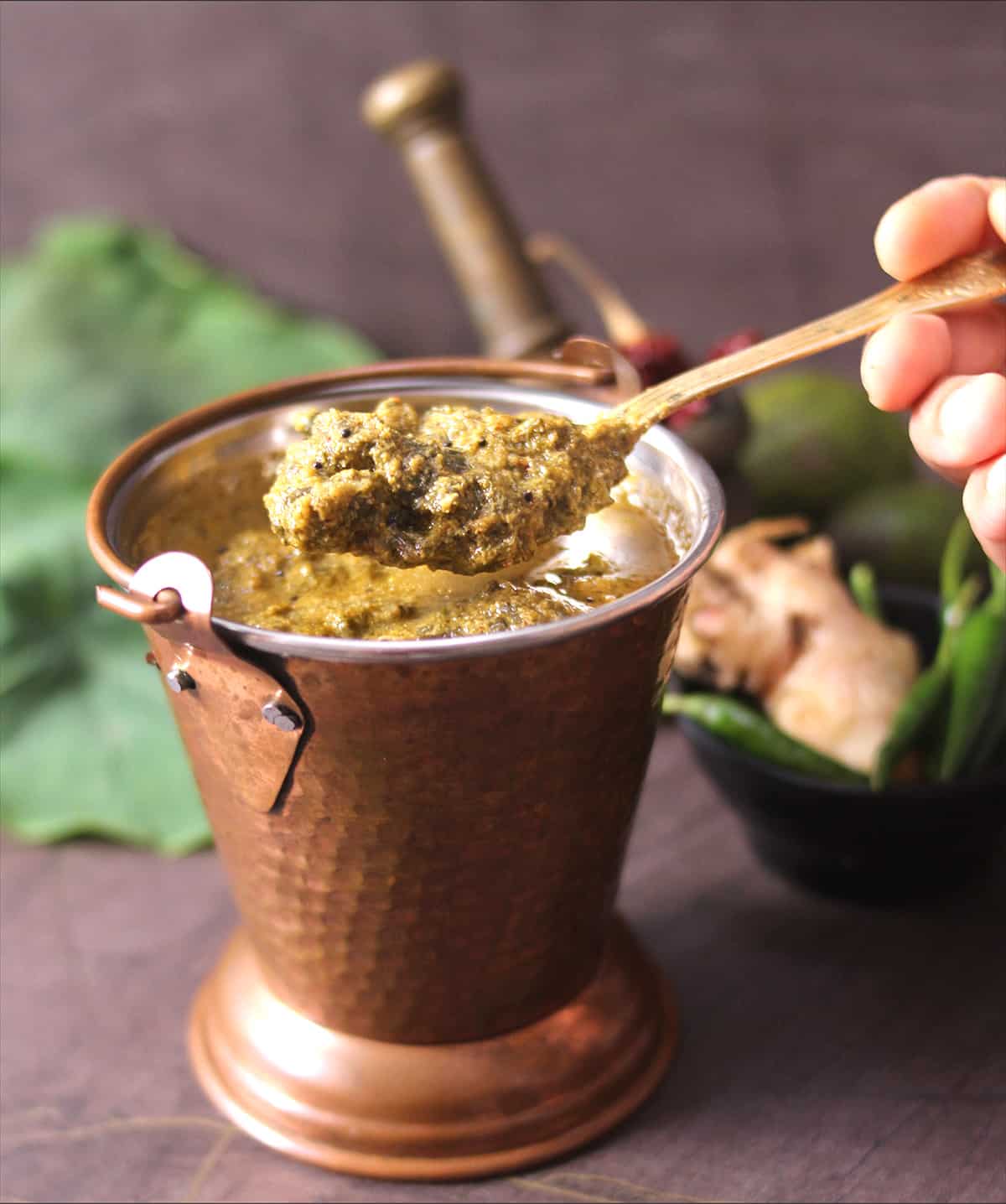
Traditional Temple Style Alvati
Temple-style Alvati is green in color. The colocasia leaves is cooked on a wood fire for 5 hours, and then the masala is added. For the masala, small round red chilies (gaongeri) are added instead of dry red chilies. This is the main reason the curry remains green, and that smoky flavor and creamy texture come from more prolonged cooking of leaves on low flame.
From the recipe above, What I have done differently today on Anant Chaturdashi to make it temple style is reduced the red chilies to 2, added extra green chile for heat, and some traditional food items like kirlu (bamboo shoot), bikkand (jackfruit seed)
Both versions taste equally good.
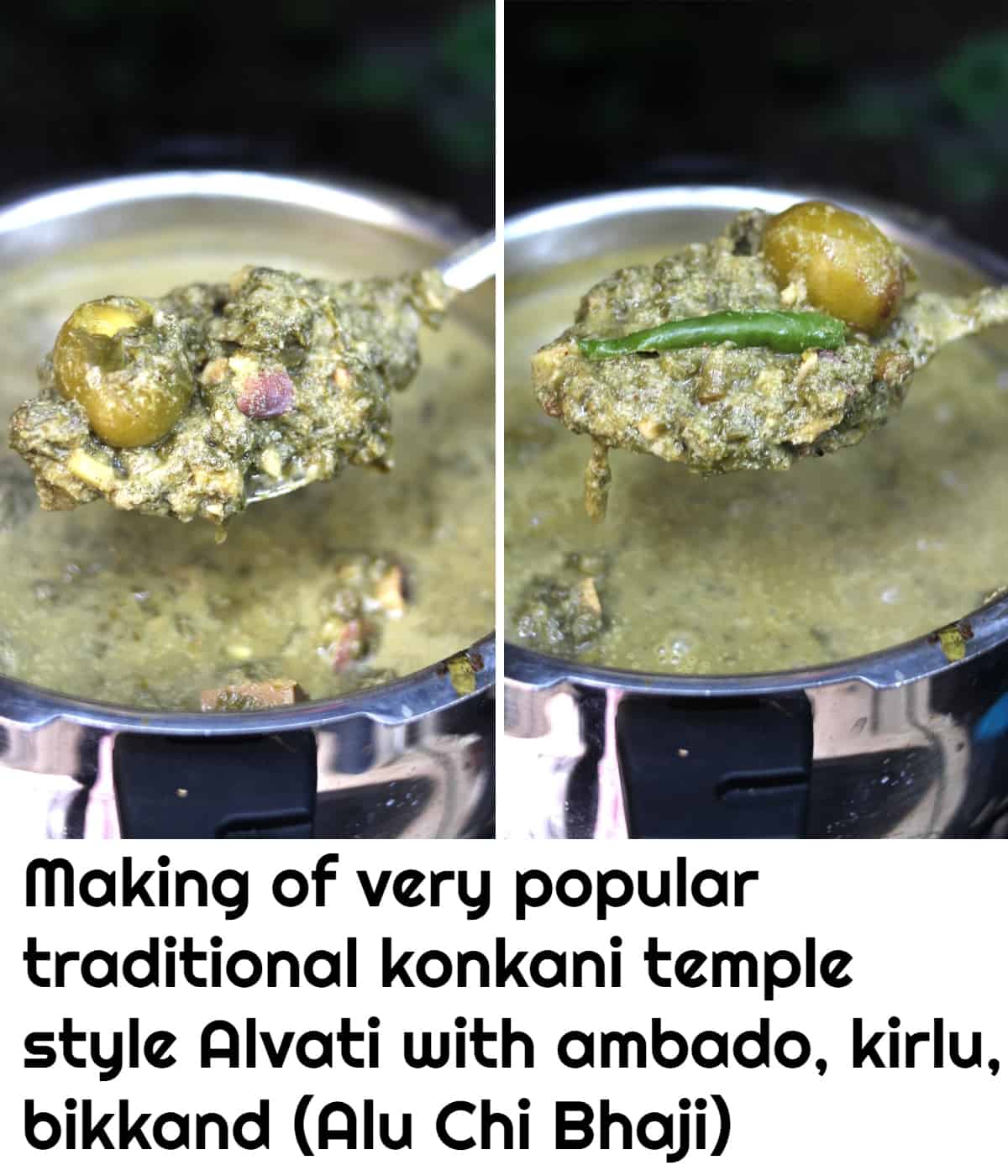
FAQs
Yes, you can. Time helps the flavors of different ingredients to combine very well. Therefore, this curry tastes even better on the second day.
If you have any leftovers, store them in the refrigerator. Reheat by adding little water to adjust the consistency of the curry..
These are available in plenty in India during the rainy season. Outside India, it is available in Indian stores or Asian stores.
If you cannot find colocasia, you can use collard greens or spinach to try this dish.
Traditionally in Konkani cuisine, freshly grated coconut is used. But you can use frozen or dry shredded unsweetened coconut for the recipe.
If you cannot find any of this, then use a lemon size ball of tamarind. Extract its pulp and add to the dish. You can even add tamarind while grinding the coconut paste.
Some more Konkani recipes to try
Video
Check out the making of the traditional alvati recipe here.
Check here for 1 minute video on making green color temple-style creamy alvati.
Recipe card
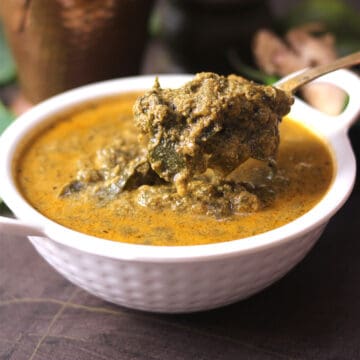
Alvati Konkani Recipe | Colocasia Leaves Curry | Alu Chi Bhaji
Equipment
- 1 Pressure cooker
- 1 Mixie Jar or Blender
Ingredients
- 6 to 8 cups Young Colocasia leaves (Taro leaves), roughly chopped
- 3 Hog plums (ambado), crushed you can even use bimbul or star fruit
- 2 inch Ginger, chopped or crushed
- 3 Green chilies, slit
- 8 to 10 Cury leaves
- ¾ teaspoon Salt, to taste
For the coconut masala
- 2 cups Coconut (loosely packed)
- 3 to 4 Dry red chilies (For green color curry, reduce red chilies to 2)
- 1 to 2 tablespoon Chopped cashews
For the tempering
- 2 tablespoon Coconut oil
- 1 teaspoon Mustard seeds
- 6 to 8 Curry leaves
Instructions
Pressure Cooking The Colocasia Leaves
- Nicely wash the roughly chopped leaves and add them to the pressure cooker along with water and pressure cook for 3 to 4 whistles. Even if you add more leaves, it is OK. The leaves are going to wilt when there are cooked. Check out the video here6 to 8 cups Young Colocasia leaves (Taro leaves), roughly chopped
- Let the cooker cool down and release the pressure naturally.
- Open the lid, and now if you see that the water is more, transfer the excess water to another vessel and use it later in the curry only if needed.
- Now using the whisk, nicely whisk the cooked leaves for a minute or two. Whisking will further break down the cooked leaves and make your dish smooth.
Make the Coconut Curry Paste
- In a mixie jar or blender, add coconut, red chilies, and cashews with little water and blend it to smooth paste.2 cups Coconut (loosely packed), 3 to 4 Dry red chilies, 1 to 2 tablespoon Chopped cashews
Making of Alvati
- To the whisked colocasia leaves, add ginger, green chilies, curry leaves, coconut paste, crushed hog plums, and salt, and bring it to a nice boil. If you feel the gravy is too thick, only then add water or reserved water from before. Else skip.2 inch Ginger, chopped or crushed, 3 Green chilies, slit, 8 to 10 Cury leaves, ¾ teaspoon Salt, to taste, 3 Hog plums (ambado), crushed
- Bring it to a boil and simmer on a medium flame for 5 to 10 minutes so that the flavors are well combined.
Make the Tempering.
- In a small pan, heat the oil. Once the oil is hot, add mustard seeds. When they start to splutter, add curry leaves and saute for a few seconds.2 tablespoon Coconut oil, 1 teaspoon Mustard seeds, 6 to 8 Curry leaves
- Finally, add the tempering to the curry and switch off the flame.
- Happy Ananth Chaturdashi to all of you!!
Notes
Nutrition
For more recent updates, follow me on Pinterest, Instagram, and Twitter.
***Click below to save it on Pinterest***
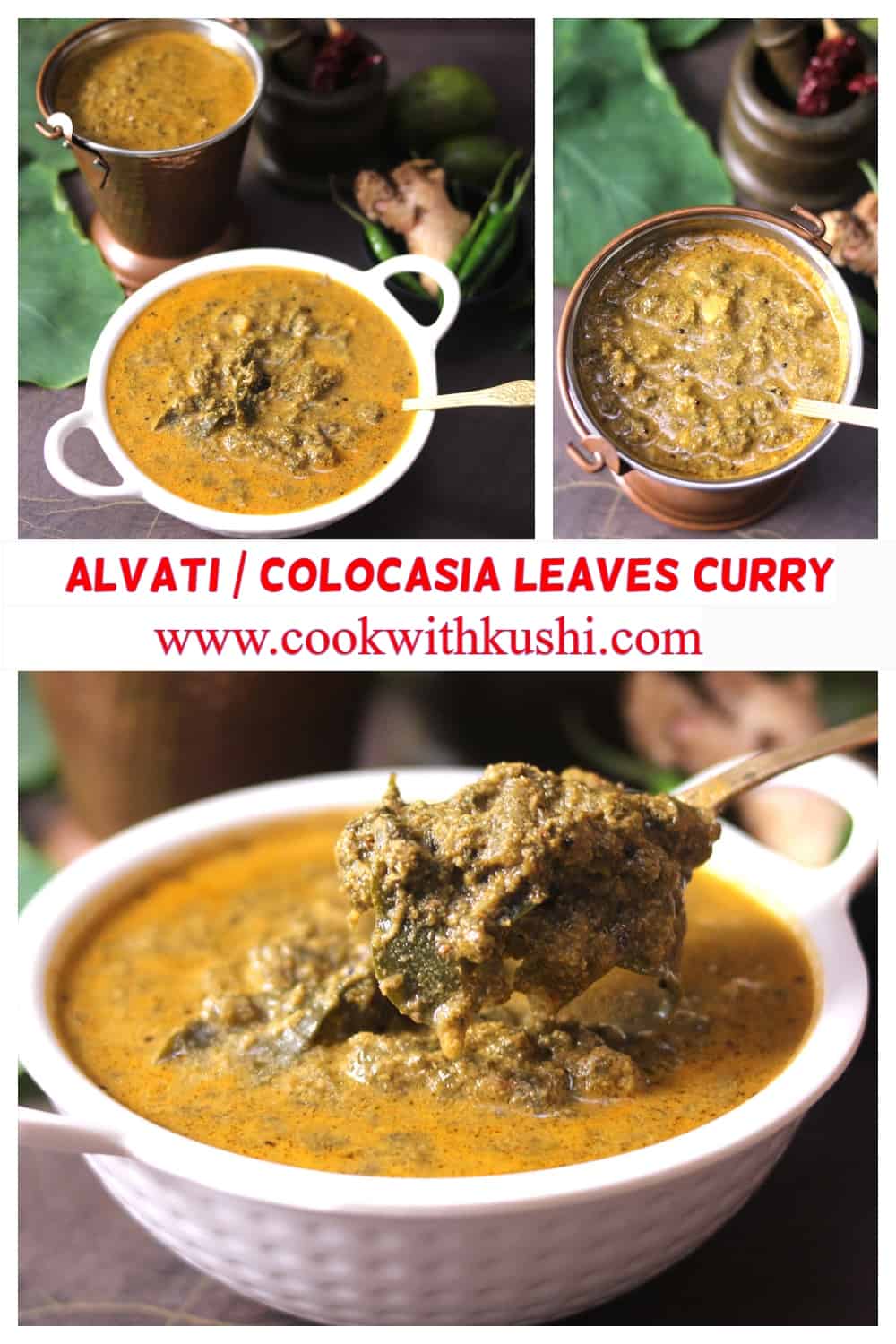

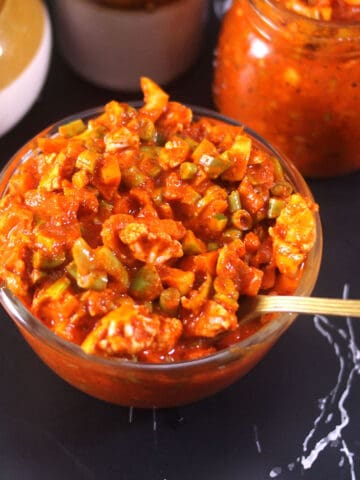

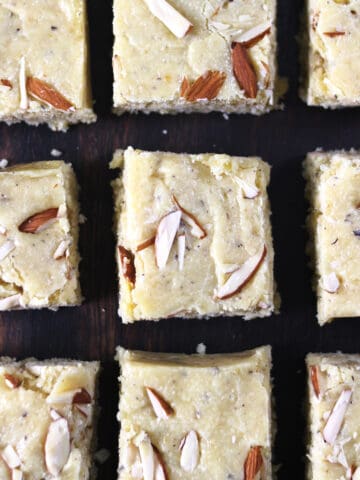
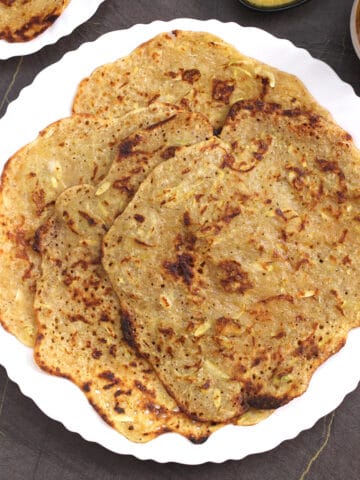
Comments
No Comments